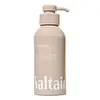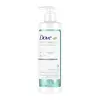What's inside
What's inside
 Key Ingredients
Key Ingredients

 Benefits
Benefits

 Concerns
Concerns

 Ingredients Side-by-side
Ingredients Side-by-side

Water
Skin ConditioningCetearyl Alcohol
EmollientBehentrimonium Chloride
PreservativeParfum
MaskingDimethicone
EmollientSqualane
EmollientHydrolyzed Rice Protein
Skin ConditioningPlumeria Acutifolia Flower Extract
Skin ConditioningCrambe Abyssinica Seed Oil
Skin ConditioningCaryocar Brasiliense Fruit Oil
Skin ConditioningPanthenol
Skin ConditioningPersea Gratissima Oil
Skin ConditioningEthyl Linoleate
EmollientButylene Glycol
HumectantEthyl Oleate
EmollientPanthenyl Hydroxypropyl Steardimonium Chloride
Polyquaternium-7
Trigonella Foenum-Graecum Seed Extract
PerfumingPhenoxyethanol
PreservativeEthylhexylglycerin
Skin ConditioningHedera Helix Extract
AntimicrobialArctium Lappa Root Extract
Skin ConditioningHelianthus Annuus Seed Oil
EmollientTetrasodium Glutamate Diacetate
Citric Acid
BufferingTocopherol
AntioxidantWater, Cetearyl Alcohol, Behentrimonium Chloride, Parfum, Dimethicone, Squalane, Hydrolyzed Rice Protein, Plumeria Acutifolia Flower Extract, Crambe Abyssinica Seed Oil, Caryocar Brasiliense Fruit Oil, Panthenol, Persea Gratissima Oil, Ethyl Linoleate, Butylene Glycol, Ethyl Oleate, Panthenyl Hydroxypropyl Steardimonium Chloride, Polyquaternium-7, Trigonella Foenum-Graecum Seed Extract, Phenoxyethanol, Ethylhexylglycerin, Hedera Helix Extract, Arctium Lappa Root Extract, Helianthus Annuus Seed Oil, Tetrasodium Glutamate Diacetate, Citric Acid, Tocopherol
Water
Skin ConditioningCetearyl Alcohol
EmollientDimethicone
EmollientStearamidopropyl Dimethylamine
EmulsifyingBehentrimonium Chloride
PreservativeGlycerin
HumectantLactic Acid
BufferingParfum
MaskingDipropylene Glycol
HumectantGluconolactone
Skin ConditioningAmodimethicone
Sodium Chloride
MaskingDisodium EDTA
PEG-7 Propylheptyl Ether
Emulsion StabilisingPhenoxyethanol
PreservativeCetrimonium Chloride
AntimicrobialMagnesium Nitrate
Niacinamide
SmoothingMethylchloroisothiazolinone
PreservativeMethylisothiazolinone
PreservativeMagnesium Chloride
Acetic Acid
BufferingBenzyl Salicylate
PerfumingHexyl Cinnamal
PerfumingLimonene
PerfumingLinalool
PerfumingWater, Cetearyl Alcohol, Dimethicone, Stearamidopropyl Dimethylamine, Behentrimonium Chloride, Glycerin, Lactic Acid, Parfum, Dipropylene Glycol, Gluconolactone, Amodimethicone, Sodium Chloride, Disodium EDTA, PEG-7 Propylheptyl Ether, Phenoxyethanol, Cetrimonium Chloride, Magnesium Nitrate, Niacinamide, Methylchloroisothiazolinone, Methylisothiazolinone, Magnesium Chloride, Acetic Acid, Benzyl Salicylate, Hexyl Cinnamal, Limonene, Linalool
Ingredients Explained
These ingredients are found in both products.
Ingredients higher up in an ingredient list are typically present in a larger amount.
This ingredient is a preservative and often used for it's anti-static properties. You'll most likely see this ingredient in hair conditioners.
It does not cause irritation or sensitization in leave-on products at 1-5%.
Cetearyl alcohol is a mixture of two fatty alcohols: cetyl alcohol and stearyl alcohol. It is mainly used as an emulsifier. Emulsifiers help prevent the separation of oils and products. Due to its composition, it can also be used to thicken a product or help create foam.
Cetearyl alcohol is an emollient. Emollients help soothe and hydrate the skin by trapping moisture.
Studies show Cetearyl alcohol is non-toxic and non-irritating. The FDA allows products labeled "alcohol-free" to have fatty alcohols.
This ingredient is usually derived from plant oils such as palm, vegetable, or coconut oils. There is debate on whether this ingredient will cause acne.
Due to the fatty acid base, this ingredient may not be Malassezia folliculitis safe.
Learn more about Cetearyl AlcoholDimethicone is a type of synthetic silicone created from natural materials such as quartz.
What it does:
Dimethicone comes in different viscosities:
Depending on the viscosity, dimethicone has different properties.
Ingredients lists don't always show which type is used, so we recommend reaching out to the brand if you have questions about the viscosity.
This ingredient is unlikely to cause irritation because it does not get absorbed into skin. However, people with silicone allergies should be careful about using this ingredient.
Note: Dimethicone may contribute to pilling. This is because it is not oil or water soluble, so pilling may occur when layered with products. When mixed with heavy oils in a formula, the outcome is also quite greasy.
Learn more about DimethiconeParfum is a catch-all term for an ingredient or more that is used to give a scent to products.
Also called "fragrance", this ingredient can be a blend of hundreds of chemicals or plant oils. This means every product with "fragrance" or "parfum" in the ingredients list is a different mixture.
For instance, Habanolide is a proprietary trade name for a specific aroma chemical. When used as a fragrance ingredient in cosmetics, most aroma chemicals fall under the broad labeling category of “FRAGRANCE” or “PARFUM” according to EU and US regulations.
The term 'parfum' or 'fragrance' is not regulated in many countries. In many cases, it is up to the brand to define this term.
For instance, many brands choose to label themselves as "fragrance-free" because they are not using synthetic fragrances. However, their products may still contain ingredients such as essential oils that are considered a fragrance by INCI standards.
One example is Calendula flower extract. Calendula is an essential oil that still imparts a scent or 'fragrance'.
Depending on the blend, the ingredients in the mixture can cause allergies and sensitivities on the skin. Some ingredients that are known EU allergens include linalool and citronellol.
Parfum can also be used to mask or cover an unpleasant scent.
The bottom line is: not all fragrances/parfum/ingredients are created equally. If you are worried about fragrances, we recommend taking a closer look at an ingredient. And of course, we always recommend speaking with a professional.
Learn more about ParfumPhenoxyethanol is a preservative that has germicide, antimicrobial, and aromatic properties. Studies show that phenoxyethanol can prevent microbial growth. By itself, it has a scent that is similar to that of a rose.
It's often used in formulations along with Caprylyl Glycol to preserve the shelf life of products.
Water. It's the most common cosmetic ingredient of all. You'll usually see it at the top of ingredient lists, meaning that it makes up the largest part of the product.
So why is it so popular? Water most often acts as a solvent - this means that it helps dissolve other ingredients into the formulation.
You'll also recognize water as that liquid we all need to stay alive. If you see this, drink a glass of water. Stay hydrated!
Learn more about Water